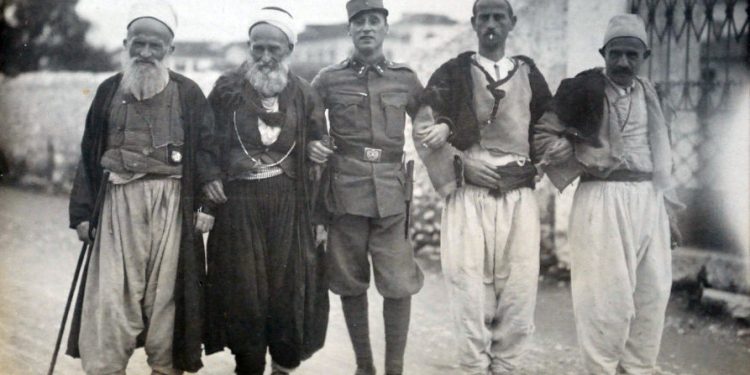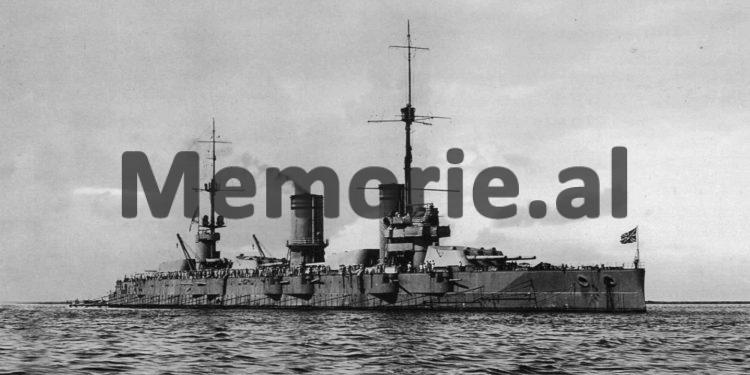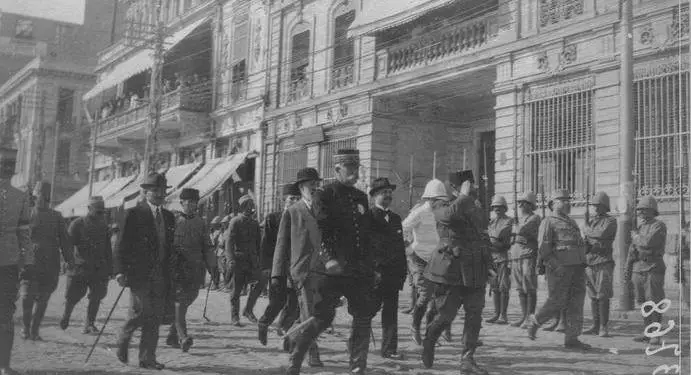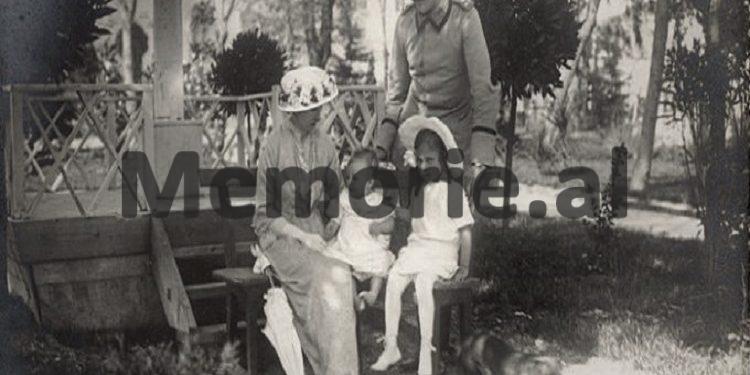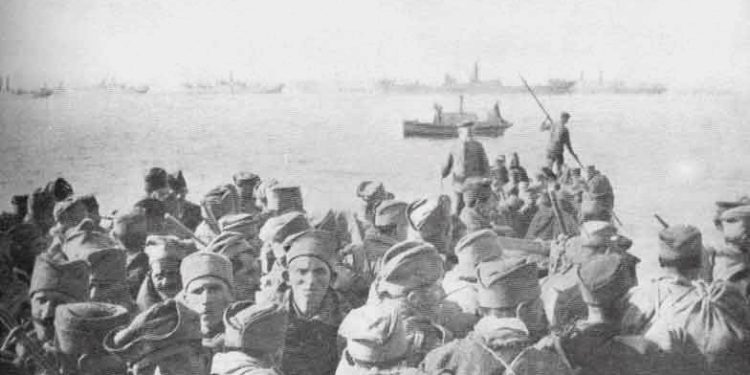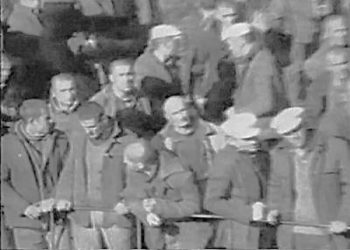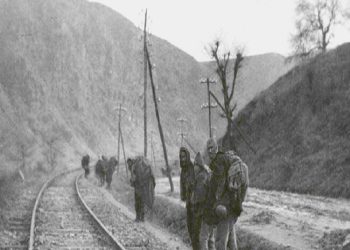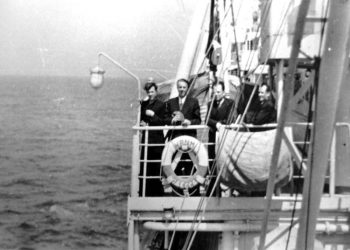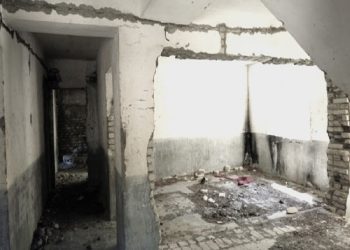By Sejfi Vllamasi
The sixth part
Memorie.al / From all the provinces of Albania, people’s delegates and a majority of patriots arrived, from inside and outside Albania, and on November 28, 1912, amid great enthusiasm, after 450 years of captivity, the flag was raised national and the independence of Albania was declared. A government was formed under the presidency of Ismail Qemali, in which Preng Bibdod Pasha also participated, as deputy prime minister, and Esat paşe Toptani as minister of the interior. When Ismail Qemali arrives in Vlora, Seit Qemali, Murat Tërbaçi, Alem Mehmeti and many other patriots, as reservists, fought against the Greek army in Llogara. These, upon being informed about the purpose of the Elder’s arrival in Vlora, raised the national flag at the front of the war, before it was raised in Vlora.
Continues from last issue
Turkey entered the war alongside the Central Powers on November 3, 1914, and on that occasion, declared war on Esat and as a traitor, the Ottoman military court sentenced him to death. On this occasion, both the Turkophiles and the Young Turks turned against Esat, but he, in order to break their resistance, arrested many themselves, including Musa Qazim and Haxhi Qamil Feza. But seeing that these arrests did not have the outcome he wanted, he released them, this time asking for their cooperation. Musa Qazimi wanted this cooperation, but he did not dare to show it.
Even the Young Turks turned against Esat and dispersed the Commission of Haxhi Ali who had gone to Istanbul to request Burhanedhim as King of Albania. Esati relied on some beylers and dibran powers and on the other hand, on his external friends; Greeks, Serbs, Montenegrins, Italy and France.
Haxhi Qamili, on November 23, 1914, burned the Tower of Esat Pasha in his fiefdom in Laprakë, as well as his houses in Tirana. He then attacked Tirana, drove out the mercenary forces of Esat under the command of Xelal Zog and Dina Hoxha. In Tirana, Haxhi Qamili also burned down the houses of Bejler and Agallar, such as Murat, Refik and Fuat Toptan, Isuf Elez, and others, most of whom were patriots.
Both Turkophile and Young Turk leaders joined Haxhi Qamili and on November 6, 1914, decided to fight Esat. Esat was surrounded in Durrës and all the villages that were under his jurisdiction automatically came under the rule of Ahl al-Qiyam. In April 1915, Durrës was attacked and heavily bombed, but the defense was also strong.
In order to escape the siege and to open the way with Central Albania and Diber, Esati, through Thessaloniki and Yugoslavia, sent Faik Kodra to Diber, to recruit a force to come to Kruja and together with the Crutan powers, to liberate Tirana and other parts of Central Albania.
Ceno Golja was in Dibër as a prefect, who prepared a force of 2,000 people and set off for Kruja, where he joined the Crutan forces. The leaders of the Crutan powers were: Sul Haka, Abaz Kupi and Hysen Kuqi. At a meeting between the two powers, it was decided to summon Esat, to come and take part in the war in person.
On 24.12.1914, he landed in Sheldinze and on 26 December, he placed his headquarters in Tapiza, and most of his forces in Zeze. Facing the power of Esat, the other side, under the command of Haxhi Qamili and Man Picari, sends a force of 2000 people, villagers and citizens of Tirana, which attacked the power of Esat in the village of Zeze in Kruja and in the battles that took place, on December 29 and 30, it was destroyed.
Esati gathered his power in Teqe e Kruja. Here, in the speech he gave to the chiefs, he promised them that he would go to Durrës to bring them food and war materials and distributed them. The Dibrans returned to Dibër, but in Qafë i Shtama, they were attacked by the Krutans, where 30 Dibrans were killed, with the intention of looting. Esati from Shëllinze, with a boat of Malik Gjyli, with 200 dibras, returned to Durrës.
Esat’s external allies, in order to exert pressure in his favor and force the rebels to maintain large forces between the various borders, acted in such a way that the Italians from the side of Vjosa, the Greeks with the Epirote gangs from the side of Berat and the Serbs from the Pogradec side, to make continuous attacks.
With the entry of Turkey into the war against the Entente, the Young Turks changed their old policy and began to follow a pro-Austrian policy. They sent various commissions to Albania to advise the insurgents to seek an independent Albania, even to recognize Vidi as king. The first commission was sent with ex-colonel Hajredin Pustina e, Hajri bey Jegeni, the second under the chairmanship of Fuat Pasha of Pristina and the third by Shefqet Peja. This policy of the Young Turks had rather the opposite effects on the insurgents.
Haxhi Qamili, a distinguished commander with a great influence in the peasantry, together with his comrades decided to pursue a policy not only against Esat, but also against the entire class of beylers, as well as against Austria and the Young Turks. So this was the second period of the uprising.
In April 1915, Haxhi Qamili became the commander-in-chief. This was a simple peasant, brave and against the oppressors and robbers, but fanatic and ignorant against the independence of Albania and for the union of Albania with Turkey. He has been against the patriots, in a word a mad fanatic.
Musa Qazimi and Haxhi Qamili, the first chairman of the General Council and the second, commander-in-chief, have been in antagonism with each other, for the reason that the first has been an opportunist and defender of the interests of the conservative party; while the second, determined defender of the little ones, of their interests and supporter of radical acts.
Serbia, defeated in the war, based on the agreement it had made before, is looking for a passage from Esati, through Central Albania. The Serbian colonel, Milutin Mishkovic, along with Ceno Golen, Qamil Biçak and Kadri bey Peqinin comes secretly to Durrës. With the participation of the Serbian consul, between them and Esat, the first agreement was renegotiated and reinforced, to give way to the Serbian army.
The Serbian army, to ensure its passage, on June 20, 1915, attacked from Struga and Dibra. Some divisions of the enemy passed through the province of Golloborda, to Central Albania. The rest of the Serbian army, coming from Kosovo, looked for a way through the Dibra valley, but Elez Isufi did not give them a way and they were forced to turn back. However, a division tries to force its way through and thus begins a bloody war in the Gorge of Veleshica – Kalle -Vleshë e Qafë e Trojaku. The entire division of 12,000 men was completely exterminated, as Elezi had given orders not to take any prisoners.
Over 2,000 or so wounded, who were found at the site of the battle, were gathered in the barracks of Qafa Trojak, as there were no medical supplies and food supplies could not come from any direction, since it was a great winter, Elezi gave the order for their mass extinction. They buried them in common pits. However, for a large part of the captives, Elez secretly, mercy was shown and they were sent to Peshkopi, intact. (Textual words of Elez; “Kill the snakes because they make small snakes and bring us back to our country”).
In revenge, the Serbian command in the city of Dibra e Madhe, that evening, caught and arrested whoever they could find, innocent people, 1000 or so people, sent them to the barracks and slaughtered them all at night. In the morning, the army fled and left the city. The names of those massacred will be published in the local history of Dibra.
Haxhi Qamili came to the border to get ahead of the Serbian army coming from Struga. Helped by the villagers of Quks and Pogradec, he fought in Quks with the Serbs. After a fight, the villagers retreated. This resulted in the emptying of Elbasan.
Haxhi Qamili, contrary to the opinions of Musa Qazim, decided to fight. Then Musa Qazim, organizing the Center, simultaneously organizes a conspiracy against Haxhi Qamili, to capture him alive. He thought that by surrendering the latter to the Serbs, he would be saved himself.
In the decisive war, Haxhi Qamili occupied the Peqin Pass, while the defense of the Krraba Pass was entrusted to Musa Qazim and Hamdi Zhegu. On June 10, the battle took place in Krrabë where, after a bloody effort, the insurgents were defeated and the Serbian army entered Tirana the next day. This gave Esat the opportunity to extend his rule in these provinces and to control all the leaders of Ahl al-Qiyam. Fifty-two of them were sentenced to death by the political court. Among them, Haxhi Qamili, Musa Qazimi, Abdullah and Mehmet Gjinali, officer Ahmet Kavaja and others.
In this case, when they told Esat that it is a sin to kill all these people, he replied: “By killing these people, I am doing a service to Albania, why, if these people are forgiven, Albania will not find peace for 40 years”. Esati was smart, realistic, courageous, and cold-blooded and a real knower of the people, but his ambition and spirit for domination led him to betrayal. Only with foreign help was he able to crush his enemies and old collaborators and take control of Central Albania, which he dreamed of ruling.
How did Italy occupy Vlora on December 24, 1914?!
From the autumn of 1914, an Italian health mission descended on Vlora, under the pretext of coming to the aid of the refugees gathered there and in the villages of Epirus. This mission consisted of officers, military doctors and military marine units.
The complete occupation of Vlora took place on December 24, 1914. Italy, seeing the first victories of the Austrian armies against Serbia and suspecting that they could arrive before her in Vlora, hastened to occupy it herself, just in case, put Austria before a fait accompli, because for Italy at that time Vlora was of great importance from the point of view of the defense of the Adriatic, where Austria also had a considerable fleet.
The occupation of Vlora by Italy was also based on political and expansionist reasons in the Balkans, creating with that action a perpetrator for the expansion he dreamed of.
Under the pretext of occupation, Italy put lawyer Jorgji Çako to empty a cocoon, which he did with the hand of Zeman Maskullora, a naive hand. Before that, he occupied the city, up to Kania and Qafa e Koçi, where he stayed for several months. The district of Vlora was ruled by the Albanian gendarmerie.
After the Italian army landed, the rebels quickly emptied Vlora and fled across Vjosa. The Italian command took over the government offices, lowered the Turkish flag, raised the Albanian and Italian flags and released the political prisoners.
At the beginning of 1915, the Italian army occupied the entire region of Vlora, up to the border with Himara, Kurvelesh and Tepelena, occupied by the Greek army.
With the departure of King Constantine and the coming to power of Venizello, and especially after the secret Pact of London that divided Albania in favor of Italy, the Italian army, with the permission of the Allies, was tasked with occupying Southern Albania, which eventually of the year 1915, he stepped up to Vjosa, Përmet e Leskovik. Following the river Osum and, dividing Skrapar in two, it comes out in Kolonje, where in the village of Qinam, it becomes the border with France.
The departure of Esat from Albania
Haxhi Qamili, contrary to the opinions of Musa Qazim, decided to fight. Then Musa Qazim, organizing the Center, simultaneously organizes a conspiracy against Haxhi Qamili, to capture him alive. He thought that by surrendering the latter to the Serbs, he would be saved himself.
In the decisive war, Haxhi Qamili occupied the Peqin Pass, while the defense of the Krraba Pass was entrusted to Musa Qazim and Hamdi Zhegu. On June 10, the battle took place in Krrabë where, after a bloody effort, the insurgents were defeated and the Serbian army entered Tirana the next day. This gave Esat the opportunity to extend his rule in these provinces and to control all the leaders of Ahl al-Qiyam. Fifty-two of them were sentenced to death by the political court. Among them, Haxhi Qamili, Musa Qazimi, Abdullah and Mehmet Gjinali, officer Ahmet Kavaja and others.
In this case, when they told Esat that it is a sin to kill all these people, he replied: “By killing these people, I am doing a service to Albania, why, if these people are forgiven, Albania will not find peace for 40 years”. Esati was smart, realistic, courageous, and cold-blooded and a real knower of the people, but his ambition and spirit for domination led him to betrayal. Only with foreign help was he able to crush his enemies and old collaborators and take control of Central Albania, which he dreamed of ruling.
How did Italy occupy Vlora on December 24, 1914?!
From the autumn of 1914, an Italian health mission descended on Vlora, under the pretext of coming to the aid of the refugees gathered there and in the villages of Epirus. This mission consisted of officers, military doctors and military marine units.
The complete occupation of Vlora took place on December 24, 1914. Italy, seeing the first victories of the Austrian armies against Serbia and suspecting that they could arrive before her in Vlora, hastened to occupy it herself, just in case, put Austria before a fait accompli, because for Italy at that time Vlora was of great importance from the point of view of the defense of the Adriatic, where Austria also had a considerable fleet.
The occupation of Vlora by Italy was also based on political and expansionist reasons in the Balkans, creating with that action a perpetrator for the expansion he dreamed of.
Under the pretext of occupation, Italy put lawyer Jorgji Çako to empty a cocoon, which he did with the hand of Zeman Maskullora, a naive hand. Before that, he occupied the city, up to Kania and Qafa e Koçi, where he stayed for several months. The district of Vlora was ruled by the Albanian gendarmerie.
After the Italian army landed, the rebels quickly emptied Vlora and fled across Vjosa. The Italian command took over the government offices, lowered the Turkish flag, raised the Albanian and Italian flags and released the political prisoners.
At the beginning of 1915, the Italian army occupied the entire region of Vlora, up to the border with Himara, Kurvelesh and Tepelena, occupied by the Greek army.
With the departure of King Constantine and the coming to power of Venizello, and especially after the secret Pact of London that divided Albania in favor of Italy, the Italian army, with the permission of the Allies, was tasked with occupying Southern Albania, which eventually of the year 1915, he stepped up to Vjosa, Përmet e Leskovik. Following the river Osum and, dividing Skrapar in two, it comes out in Kolonje, where in the village of Qinam, it becomes the border with France.
The departure of Esat from Albania
With the withdrawal of the Serbs, Esati was also preparing to leave Albania, and sometimes with grace and without grace, he forced the employees to leave with him and finally he left with the Serbs, who landed in Corfu.
Esati himself went to Paris and, through the intermediary of the French Government, agreed with the Greek and Serbian Governments and formed a temporary government in Thessaloniki. He himself was staying in Paris, while in Thessaloniki, he had left Faik Kodra.
All the immigrants who were with him were paid their salaries. He had formed a battalion of soldiers under the command of Hal Lleshi. This battalion, together with the French army, took part in the war of Dry Mountain and Mokre. Halit Lleshi was a major in the French army.
Esati in Thessaloniki had a small guard. When he once came to Thessaloniki, he was given a grand reception by General Serrai. King Alexander of Serbia was also waiting. Esat was taken in a car and stabbed in his palace. As long as he stayed in Thessaloniki, a company of soldiers, consisting of a platoon from each allied country, paid the occasional honors.
During the Peace Conference, Esati stayed in Paris. His government was in Thessaloniki, while in Dibër there was a committee composed of Ymer Efendi, Pasha’s secretary, Hysen Kuqi, Hafis Hasa (Mat) and others and a force of 1000 people, with commander Halit Lleshi and sub-commanders Taf Kazina. Dine Hoxha, Osman Mema and Jusuf bey Çela.
The situation in Shkodër in 1914-1915
After the beginning of the World War, the international powers withdrew from Shkodër and handed over the city to a commission of 12 people, consisting of 6 Catholics and 6 Muslims. With the departure of Vidi, the great majority of patriots gathered and found shelter in Shkodër. The commission remained at the head of the administration until July 15, 1915, when Montenegro entered Shkodër for the second time.
The commission administered the city and districts. It was without leadership and among the acts, the signature was: “Commission of Shkodra”. The Commission has not been homogeneous, in the heat and simmering resentment and dissatisfaction inherited from the time of internationals. On things of no importance, they seemed to agree, but in reality they were divided by anger and mentality. The commission in the country’s administration proved to be incompetent. The gendarmerie and the police also showed up.
Nikoll Marashi, a close associate of Alush Lohja, is killed by Rrok Jakovo, but he is also killed instantly by the police. The opinion of some circles of the country was that this political murder was done at the instigation of Preng Pasha and Bajram Curri. At the push of one party, the villagers of the Buna coast stop the goods being loaded in Buna for Shkodër. The heated blood for a fight cooled down with the mediation of the Commission and the case was closed.
Later, Alush Lohja, comes out with a force in Tarabosh, to stop the circulation through the waters of Buna, as a response to the event of the Buna Coast. The commission closed this issue as well, after reaching an agreement with Alushi. All these confusions were made by the members of the Commission, in order to show their influence over their friends. Memorie.al






